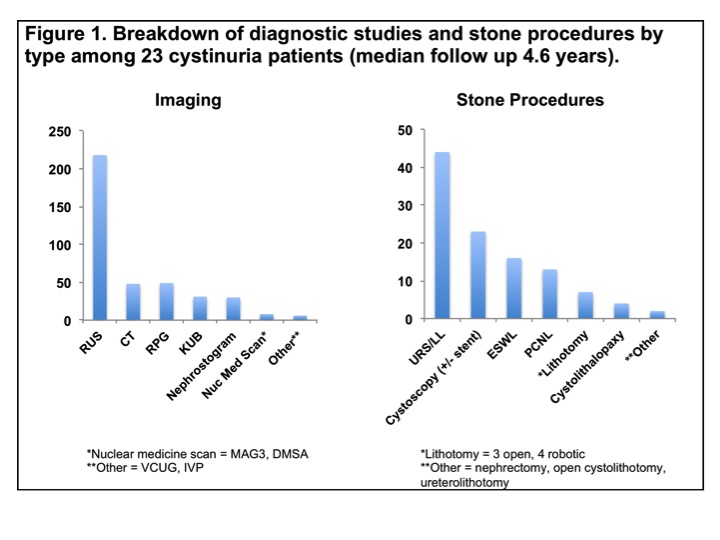-->
|
Back to 2014 Fall Congress Meeting Posters
Cystinuria in the pediatric population: understanding the burden of disease
Briony K. Varda, MD1, Emilie K. Johnson, MD, MPH2, Kathryn L. Johnson, BA2, Ilina Rosoklija, MPH2, Caleb P. Nelson, MD, MPH2.
1Boston Children's Hospital & Brigham and Women's Hospital, Harvard Medical School, Boston, MA, USA, 2Boston Children's Hospital, Harvard Medical School, Boston, MA, USA.
Background
Although cystinuria is rare, its clinical manifestations are lifelong, with a majority of patients presenting during childhood and adolescence. However, little is known about healthcare utilization and burden of illness in this population. We sought to assess the initial presentation and subsequent utilization of imaging and surgery among pediatric patients presenting with cystinuria.
Methods
Through billing records and chart review, we identified 23 patients with cystinuria treated at our institution between 1995 and 2012. Clinical presentation, diagnostic testing, and surgical procedures were recorded.
Results
Median age at presentation was 12 years and 11/23 patients were male. Pain, nausea, fever and gross hematuria were the most common presenting symptoms, although 5 patients were identified on sibling screening. The median number of stones at presentation was 2.0 and the median size of the largest stone at presentation was 9mm. Four patients presented with staghorn calculi and 12/46 renal units were hydronephrotic.
Median follow-up was 4.55 years (range 1.00-17.2), during which time a total of 110 stone procedures were performed in 15/23 patients; 9 patients underwent >3 procedures during follow-up. The average annual number of procedures per patient ranged from 0 to 2.99 (median: 1.00). Five patients underwent 13 PCNL procedures, 11 patients underwent 44 ureteroscopy procedures, and 9 underwent open or robotic surgery, including 1 nephrectomy. Eight patients (4 identified by sibling screen) were managed medically without requiring surgery.
The 23 patients underwent a total of 390 imaging procedures. The average annual number of imaging tests per patient ranged from 0.44 to 12.97 (median: 3.03). Twenty-three patients had 218 ultrasounds, 13 had 48 CT scans, 13 had 79 antegrade or retrograde fluoroscopic studies, 10 had 31 KUBs, and 6 had 14 other types of imaging. Radiation-associated imaging comprised half of the total imaging obtained.
Conclusion
The burden of disease among pediatric patients presenting with cystinuria is considerable with a majority requiring surgical treatment. This population also generates heavy utilization of diagnostic imaging. Given the lifelong nature of this disease, research on improved preventive therapies is urgently needed.

Back to 2014 Fall Congress Meeting Posters
|


